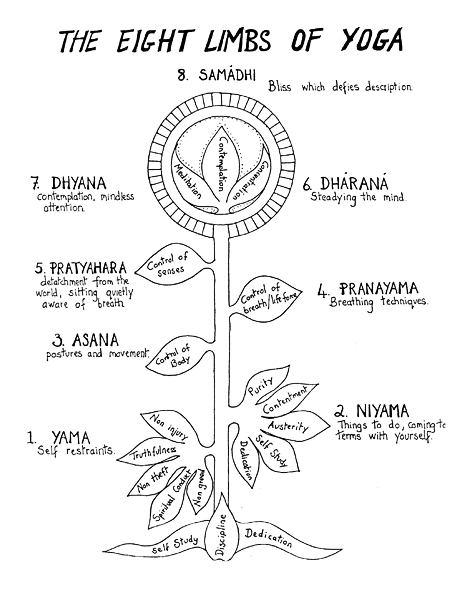
What is Ashtanga Yoga?
Ashtanga means “eight limbs“. Ashtanga Yoga is the eight limbed yoga, laid out by Patanjali in the Yoga Sutras of Patanjali (sutras = thought-threads, at least 4,000 years old text, covering the yogic teachings on ethics, meditation, and provide directions for dealing with situations in daily life.) The eight limbs are:
Yamas (universal codes of conduct)
Niyamas (personal codes of conduct)
Asanas (postures)
Pranayama (breath/vital energy control)
Pratyahara (withdrawal of the senses)
Dharana (concentration)
Dhayana (meditation)
Samadhi (liberation)
It is important to highlight that Ashtanga Yoga is not equivalent to the asanas only. The asana practice is often titled as Ashtanga Vinyasa Yoga, vinyasa meaning uniting breath and movement.
Another thing to also highlight is the importance of the word “limb“. It is not “steps“ or “stages“ implying that it is a step by step progression until the last stage, samadhi. The eight limbs are meant to practiced simultaneously depending on the student’s level of practice. In each limb there are easier and more advanced practices, suiting everyone’s needs.
The Ashtanga Vinyasa Yoga system has 6 series of postures:
Primary series - yoga chikitsa = yoga therapy
Secondary series - nadi shodana = nerve cleansing
Advanced series (A,B,C,D) - sthira bhaga = divine stability
Traditionally one would practice 6 times a week, leaving Saturdays and Moon days (new and full Moon) as rest days. Ladies can also take time off during menstruation.
In each sequence the practice begins with 5 rounds of surya namaskara a (sun salutation a) and 3 rounds of surya namaskara b (sun salutation b). From there we begin with a standing sequence of postures which then leads to each different series, and closing off with the closing sequence of postures.
The foundation of the practice is tristana, a tool to help cultivate the presence of mind, focus and stability. The three parts are:
Ujjayi breath - ocean or victorious breath, to help synchronise asanas with vinyasa
Bandhas - energetic locks in the body, to support alignment and stability
Dristhi - yogic gaze, internal and external focus
Ashtanga Vinyasa Yoga is mostly practiced Mysore-style, meaning that once students have learnt the sequence of postures and the vinyasa count, they would practice with their own pace of breath. The teacher supports this practice with verbal and hands-on adjustments if needed, to help correct alignment and achieve the full expression of poses. The practice can be modified and adjusted based on the student’s needs. When one has firmly established certain poses/segments of the practice, he or she would get further poses to work on from the more advanced series. Similarly, when learning a new sequence, at the beginning one may only practice till a certain stage, until the body opens and strengthens up for the further parts of that series.
Led classes are useful for students to help memorise the poses and breath placement. Practice of your own is still extremely beneficial to integrate that knowledge.
Traditionally we begin the practice before sunrise, although work hours may effect that rhythm. It is highly recommended that once one has established a practice at a certain time, keep that same time of practice for each day. It is because the body needs to rest and recover between two practices to avoid over-exhaustion and injuries.
What will you experience in my Ashtanga classes?
What is Ashtanga Yoga all about?
Yoga Asanas
Learn the postures of the ashtanga primary or secondary series. Depending on where you are in the practice, learn the correct alignment, count and transitions in the first two ashtanga sequences.
Breath is The Bridge
Breathe, balance, blossom and become more tranquil in the mind. Learn to manage stress on the physical and mental level. Release stress through physical movement, pacify the nervous system using the power of the breath.
Mindful Movement
Learn to be conscious in your body on and off the mat throughout your day. Practice regularly to increase awareness in your body. Increase focus and tame the mind.
Ground Yourself in The Self
Connect to yourself. Healing the relationship with ourselves through bodily movements and the breath helps us expand and connect better with others too.
Strength & Flexibility
There is work for everyone within the practice. The ashtanga sequences make the body strong, flexible and lean, when paired with a conscious lifestyle, bringing us health and glow.
Yogic Lifestyle
Learn about all the 8 limbs of ashtanga yoga and familiarise yourself with yogic routines. Explore yoga beyond the asanas and immerse yourself in a modern lifestyle that’s anchored in ancient wisdom.








